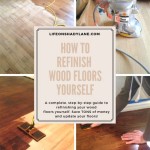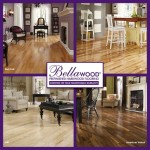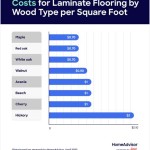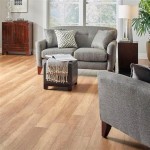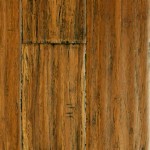Woven Bamboo Flooring: Exploring the Advantages and Disadvantages
Woven bamboo flooring represents a unique and increasingly popular alternative to traditional hardwood flooring options. Through a distinct manufacturing process, bamboo strands are compressed and adhered under high pressure, resulting in a durable and aesthetically appealing surface. Like any flooring material, however, woven bamboo possesses both advantages and disadvantages that should be carefully considered before installation.
This article aims to provide a comprehensive overview of the pros and cons associated with woven bamboo flooring. By examining these aspects, homeowners and builders can make informed decisions tailored to their specific needs and preferences, ensuring the selection of a flooring solution that aligns with their expectations for longevity, aesthetics, and environmental impact.
Examining the Advantages of Woven Bamboo Flooring
Woven bamboo flooring boasts several key benefits that contribute to its growing popularity among consumers. These advantages range from its exceptional durability and distinctive appearance to its environmental friendliness and relatively straightforward maintenance requirements.
Exceptional Durability and Hardness
One of the most significant advantages of woven bamboo flooring is its exceptional durability. The manufacturing process, which involves compressing and bonding individual bamboo strands under intense pressure, results in a flooring material significantly harder than many traditional hardwoods. In fact, woven bamboo typically ranks higher on the Janka hardness scale, a measure of a wood's resistance to denting and wear, than species such as oak, maple, and even some exotic hardwoods.
This enhanced durability makes woven bamboo flooring particularly well-suited for high-traffic areas within a home, such as hallways, living rooms, and kitchens. The resistance to dents, scratches, and general wear and tear ensures that the flooring maintains its aesthetic appeal for an extended period, reducing the need for frequent repairs or replacements. The inherent strength of woven bamboo also makes it a suitable choice for homes with pets or children, where flooring is often subjected to increased use and potential damage.
The longevity afforded by woven bamboo's hardness contributes to its overall value proposition. While the initial investment may be comparable to other flooring options, the extended lifespan and reduced maintenance requirements can translate to significant cost savings over the long term.
Aesthetically Pleasing and Versatile Design Options
Beyond its durability, woven bamboo flooring offers a distinctive and aesthetically pleasing appearance. The unique grain patterns and textures created during the manufacturing process provide a visual depth and richness that is not typically found in traditional hardwood floors. This inherent visual appeal can enhance the overall aesthetic of a room, adding a touch of sophistication and natural beauty.
Woven bamboo is available in a wide range of colors and finishes, allowing homeowners to select a style that complements their existing décor and personal preferences. From light and airy tones to dark and rich hues, the versatility of woven bamboo enables seamless integration into various design schemes. The availability of different plank widths and lengths further expands the design possibilities, allowing for customized installations that cater to specific room dimensions and aesthetic goals.
The versatility of woven bamboo extends to its compatibility with various architectural styles. It can be effectively used in both modern and traditional settings, adding a touch of natural elegance to any space. The unique texture and visual interest of woven bamboo can also serve as a focal point within a room, creating a visually engaging and inviting atmosphere.
Environmentally Friendly and Sustainable Material
In an era of growing environmental awareness, the eco-friendly nature of woven bamboo flooring is a significant selling point. Bamboo is a rapidly renewable resource, capable of reaching maturity in just a few years, compared to the decades required for hardwood trees to mature. This rapid growth rate makes bamboo a sustainable alternative to traditional wood flooring, reducing the pressure on global forest resources.
The harvesting and processing of bamboo generally have a lower environmental impact compared to the extraction and milling of hardwoods. Bamboo cultivation often requires less water and pesticides, minimizing the ecological footprint associated with its production. Furthermore, many manufacturers of woven bamboo flooring adhere to sustainable harvesting practices, ensuring that the resource is managed responsibly.
By choosing woven bamboo flooring, homeowners can contribute to environmental conservation and promote sustainable building practices. The use of a rapidly renewable resource helps to reduce deforestation and minimize the overall impact on the planet's ecosystems. This environmentally conscious choice aligns with the growing trend towards sustainable living and responsible consumption.
Relatively Easy Maintenance and Cleaning
Maintaining woven bamboo flooring is generally a straightforward process, requiring minimal effort and specialized cleaning products. Regular sweeping or vacuuming is typically sufficient to remove dust and debris. For more thorough cleaning, a damp mop with a pH-neutral cleaner can be used to effectively remove dirt and stains.
The durable surface of woven bamboo is relatively resistant to staining and damage from spills. However, it is advisable to clean up spills promptly to prevent any potential discoloration or water damage. The use of protective mats or rugs in high-traffic areas can further minimize wear and tear and extend the lifespan of the flooring.
Unlike some hardwood floors that require periodic refinishing, woven bamboo typically maintains its appearance for an extended period with proper care. This reduces the long-term maintenance costs associated with the flooring and minimizes the disruption to the household caused by refinishing projects. The ease of maintenance and cleaning makes woven bamboo a practical and convenient flooring option for busy homeowners.
Evaluating the Disadvantages of Woven Bamboo Flooring
While woven bamboo flooring offers numerous advantages, it is essential to acknowledge the potential drawbacks associated with its use. These disadvantages may include susceptibility to moisture damage and potential variations in quality.
Susceptibility to Moisture Damage and Humidity
One of the primary drawbacks of woven bamboo flooring is its susceptibility to moisture damage and humidity fluctuations. Like all wood-based flooring materials, bamboo can absorb moisture from the surrounding environment, leading to swelling, warping, or even mold growth. This makes woven bamboo flooring less suitable for areas with high humidity levels, such as bathrooms, laundry rooms, or basements that are prone to dampness.
Excessive moisture can compromise the structural integrity of the flooring, causing the planks to expand and contract, leading to gaps and uneven surfaces. In extreme cases, prolonged exposure to moisture can result in irreversible damage, requiring costly repairs or replacements. To mitigate the risk of moisture damage, it is crucial to ensure proper ventilation and humidity control in areas where woven bamboo flooring is installed.
The use of moisture barriers during installation can also help to protect the flooring from excessive moisture. Additionally, it is advisable to avoid wet mopping and to promptly clean up any spills to prevent water from seeping into the flooring. Regular monitoring of humidity levels within the home is essential to maintain the integrity and longevity of the woven bamboo flooring.
Potential Variations in Quality and Manufacturing Standards
The quality of woven bamboo flooring can vary significantly depending on the manufacturer and the specific production processes employed. Some manufacturers may use lower-quality bamboo or less stringent manufacturing standards, resulting in flooring that is less durable, prone to defects, or susceptible to moisture damage. It is crucial to research different brands and suppliers thoroughly to ensure that the woven bamboo flooring meets the required quality standards.
Variations in the adhesive used to bond the bamboo strands can also affect the durability and longevity of the flooring. Some adhesives may be less resistant to moisture or temperature fluctuations, potentially leading to delamination or structural failure. It is advisable to inquire about the type of adhesive used and to seek out manufacturers who utilize high-quality, water-resistant adhesives.
To ensure the quality and authenticity of woven bamboo flooring, it is recommended to purchase from reputable suppliers who can provide certifications and warranties. These certifications can provide assurance that the flooring meets certain industry standards and that the manufacturer is committed to quality control. Thorough research and careful selection of a reputable supplier are essential to avoid purchasing substandard woven bamboo flooring.
Potential for Off-Gassing of Volatile Organic Compounds (VOCs)
Like many manufactured products, woven bamboo flooring can potentially emit volatile organic compounds (VOCs), which are organic chemicals that can vaporize at room temperature. Some VOCs can have adverse health effects, such as respiratory irritation, headaches, and nausea. The amount of VOCs emitted by woven bamboo flooring can vary depending on the adhesive used in the manufacturing process. Flooring that utilizes formaldehyde-based adhesives is more likely to emit higher levels of VOCs.
To minimize the risk of VOC exposure, it is advisable to choose woven bamboo flooring that is certified as low-VOC or VOC-free. These certifications indicate that the flooring has been tested and meets specific standards for VOC emissions. Additionally, adequate ventilation during and after installation can help to dissipate any VOCs that may be released.
Selecting woven bamboo flooring with recognized certifications, such as FloorScore or GREENGUARD, ensures that the product meets stringent standards for indoor air quality. These certifications provide assurance that the flooring has been tested for a wide range of VOCs and that it complies with established safety levels. Choosing low-VOC or VOC-free woven bamboo flooring can contribute to a healthier indoor environment and minimize the potential for adverse health effects.
Limited Availability Compared to Traditional Hardwood
While the popularity of woven bamboo flooring has been increasing, it is still less readily available compared to traditional hardwood flooring options. This limited availability can make it more challenging to find specific styles, colors, or plank sizes. It may also result in longer lead times for orders, particularly for custom installations or large projects.
The limited availability of woven bamboo flooring can also impact the cost of the material. Due to lower production volumes and potentially higher transportation costs, woven bamboo flooring may be more expensive than some traditional hardwood options in certain regions. It is advisable to compare prices from multiple suppliers and to factor in any additional costs associated with shipping or installation.
Despite the potential for limited availability, the increasing demand for sustainable and aesthetically appealing flooring options is likely to drive increased production and distribution of woven bamboo flooring in the future. As the market for woven bamboo continues to grow, its availability and affordability are expected to improve, making it an increasingly viable alternative to traditional hardwood.

Bamboo Flooring Pros And Cons Forbes Home

Pros And Cons Of Bamboo Flooring

Advantages And Disadvantages Of Bamboo Flooring The Company

The Pros And Cons Of Bamboo Flooring Astrobrite Local Family Run

The Pros Cons Of Bamboo Flooring Plus It S History

Pros Cons Of Bamboo Flooring Claude Browns

Bamboo Flooring Pros Cons Advantages Disadvantages

Engineered Bamboo Flooring Pros And Cons Best Brands Floorings

Bamboo Flooring Pros Cons

Bamboo Flooring Pros Cons S
Related Posts



